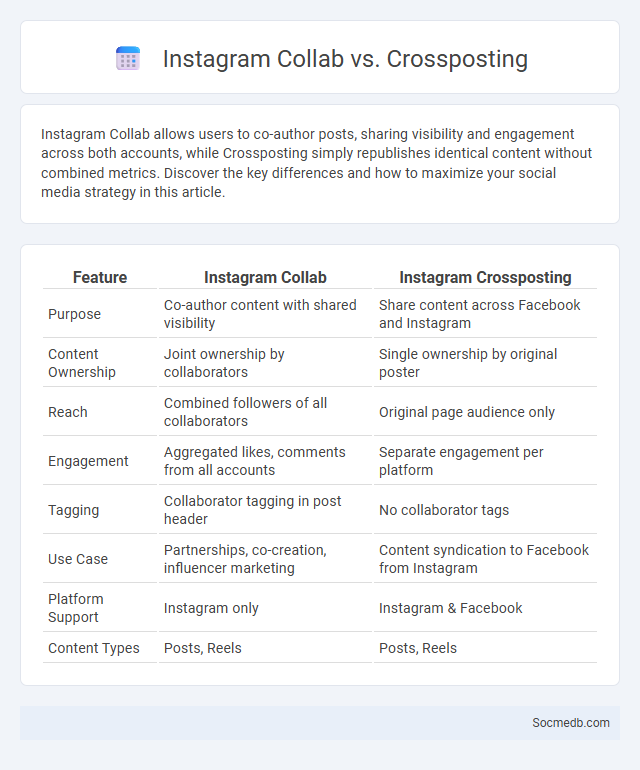
Photo illustration: Instagram Collab vs Crossposting
Instagram Collab allows users to co-author posts, sharing visibility and engagement across both accounts, while Crossposting simply republishes identical content without combined metrics. Discover the key differences and how to maximize your social media strategy in this article.
Table of Comparison
| Feature | Instagram Collab | Instagram Crossposting |
|---|---|---|
| Purpose | Co-author content with shared visibility | Share content across Facebook and Instagram |
| Content Ownership | Joint ownership by collaborators | Single ownership by original poster |
| Reach | Combined followers of all collaborators | Original page audience only |
| Engagement | Aggregated likes, comments from all accounts | Separate engagement per platform |
| Tagging | Collaborator tagging in post header | No collaborator tags |
| Use Case | Partnerships, co-creation, influencer marketing | Content syndication to Facebook from Instagram |
| Platform Support | Instagram only | Instagram & Facebook |
| Content Types | Posts, Reels | Posts, Reels |
Understanding Instagram Collab, Crossposting, and Collaboration
Instagram Collab enables users to co-author posts and reels, enhancing content reach by sharing it between different accounts. Crossposting allows you to publish the same content across multiple platforms, boosting engagement and maintaining consistent messaging. Collaboration fosters authentic partnerships, leveraging diverse audiences to increase visibility and drive meaningful interactions.
Key Differences Between Instagram Collab and Crossposting
Instagram Collab enables two users to co-author a single post or Reel that appears on both profiles, each sharing likes, comments, and reach, enhancing collaborative engagement. Crossposting allows the same content to be shared across platforms like Facebook and Instagram without merging interactions or metrics, making it ideal for wider distribution but separate audience targeting. Collab boosts visibility through joint audiences and unified analytics, while crossposting streamlines content sharing without integrating engagement data.
What Is an Instagram Collab Feature?
The Instagram Collab feature allows two users to co-author a single post or reel, sharing visibility, likes, and comments across both profiles. This tool enhances engagement by combining follower bases and increasing content reach organically. Brands and influencers utilize Collabs to boost collaborative marketing efforts and drive authentic audience interactions effectively.
Crossposting Content on Instagram Explained
Crossposting content on Instagram enables you to share the same post seamlessly across multiple social media platforms, enhancing your reach without extra effort. This strategy maximizes your content's visibility by leveraging Instagram's integration with Facebook, Twitter, and other networks, driving higher engagement from diverse audiences. Efficient crossposting saves time, maintains brand consistency, and boosts your online presence effectively.
Traditional Collaboration on Instagram: A Brief Overview
Traditional collaboration on Instagram involves brands partnering with influencers or other businesses to create sponsored content that enhances brand visibility and engagement. This strategy leverages follower trust and authentic storytelling to drive product awareness and increase follower growth. Metrics such as engagement rate, reach, and conversion tracking are crucial for measuring the success of these collaborative campaigns.
Pros and Cons: Collab vs Crossposting vs Collaboration
Collaborating on social media merges diverse audiences, fostering authentic engagement and innovative content, while crossposting efficiently amplifies reach with minimal extra effort but risks audience fatigue due to repetitive posts. Collaboration entails a deeper, creative partnership yielding unique content and stronger brand alignment, contrasting with crossposting's straightforward content redistribution and collab's flexible teamwork-driven approach. Weighing these methods involves balancing content originality, audience engagement quality, and resource investment to maximize social media impact.
How Each Method Impacts Engagement and Reach
Different social media methods impact engagement and reach by targeting users through tailored content formats such as videos, stories, and live streams, which often generate higher interaction rates compared to static posts. Algorithms prioritize content style based on user behavior metrics like watch time, shares, and comments, directly influencing visibility across platforms like Instagram, Facebook, and TikTok. Consistent use of hashtags, optimal posting times, and community interaction further enhances reach and engagement by encouraging organic discovery and fostering audience loyalty.
Content Ownership and Attribution Considerations
Content ownership and attribution are critical in social media to protect your intellectual property and ensure proper credit. Maintaining clear rights over your original posts prevents unauthorized use while attributing sources enhances credibility and fosters trust among your audience. Understanding platform-specific policies and copyright laws safeguards your content and respects the contributions of others.
Choosing the Right Strategy for Your Instagram Goals
Selecting the right Instagram strategy requires understanding your target audience's preferences and behavior patterns. Key tactics include leveraging Instagram Stories for real-time engagement, utilizing the platform's shopping features for e-commerce growth, and incorporating consistent, high-quality visual content aligned with brand identity. Tracking metrics like engagement rate, follower growth, and click-through rates helps refine your approach to meet specific business objectives effectively.
Best Practices for Successful Instagram Partnerships
Maximize your Instagram partnerships by selecting influencers whose audience aligns closely with your target demographic, ensuring authentic engagement and brand synergy. Craft clear, mutually beneficial agreements outlining content expectations, posting schedules, and performance metrics to maintain transparency and accountability. Monitor campaign analytics regularly to optimize reach, engagement rates, and return on investment, refining strategies for continued success.
 socmedb.com
socmedb.com